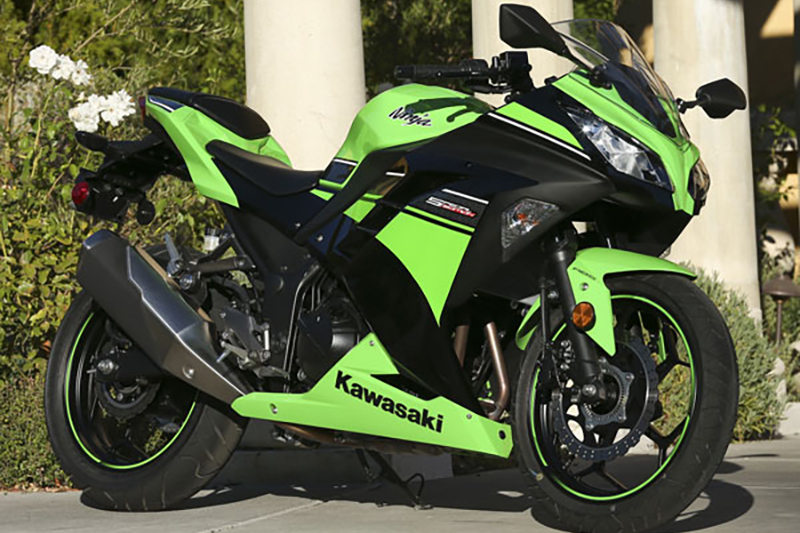2013 Kawasaki Ninja 300 ABS

First Ride Review
Like its ain’t-broke-don’t-fix-it KLR650 dual-sport, Kawasaki produced the Ninja 250 for more than two decades before giving it a major overhaul for 2008. Styling went from utilitarian to sporty and updates to the engine boosted midrange. The wee Ninja’s monopoly of the quarter-liter sportbike market continued and the $3,999 pocket rockets sold by the truckload.
But then winter came. The Honda CBR250R debuted in 2011, offering fuel injection, more torque, better gas mileage and lighter, more nimble handling for the same price, plus optional ABS.
Thusly challenged, Kawasaki drew its sword and an army of engineers mounted an assault. For 2013, the smallest Ninja underwent a growth spurt, its liquid-cooled parallel twin now displacing 296cc instead of 249cc thanks to a longer stroke (49.0mm, up from 41.2mm). Many of the engine’s components are new, from the digital fuel injection system to the easy-to-access, spin-on oil filter. Other changes include a new clutch with assist and slipper functions, a more rigid frame, retuned suspension, and new 17-inch, 10-spoke wheels. Optional ABS uses a Nissin control unit said to be the world’s smallest and lightest, adding just 4.5 pounds.
The Ninja 250R looks cute and cuddly when parked next to the aggressively styled Ninja 300, with bodywork inspired by the take-no-prisoners Ninja ZX-10R. One-third of Ninja 250R owners are female, and it has been the top-selling bike among women. Will the hardcore look be appealing or a turn-off? Hard to say, but the Ninja 300’s integrated turn signals, digital instrumentation, flared fuel tank (4.5-gallon capacity, down from 4.8) and excellent fit-and-finish are on par with motorcycles that cost twice as much as the $4,799 base price. Add $200 for the special-edition Lime Green/Ebony paint, $500 more for ABS.
At the press launch in Northern California, Kawasaki set us loose on Stewarts Point-Skaggs Springs Road, a sparsely traveled, technical road that connects the Russian River valley to the Pacific Coast Highway. The Ninja 300’s tall handlebars meant that I didn’t have to hunch over the bike and I never felt cramped. Seat height is now 30.9 inches (up from 30.5), but the slimmer seat makes it easy to reach the ground.
Fuel injection has transformed the Ninja from dull and languid to crisp and precise, and those extra 47cc make a big difference. The 250R didn’t really have a powerband; you just kept it pinned near the rev limiter and waited for speed to gradually increase. On the 300, you still need to keep it spun up, but the window from 9,000 rpm to the 13,000-rpm redline offers much more horsepower and torque than before.
If you haven’t ridden a small bike in a while, do yourself a favor and give it a go. By shedding excess weight and complexity, the ride becomes about fun, not lifestyle or skill set. Riding the Ninja 300 on a twisty road is an absolute delight, with piece-of-cake handling, feathery clutch action and effortless shifting. The suspension and brakes get the job done, but both are on the soft side—this is a sub-$5,000 bike, after all. Given the weakness of the two-disc binders, you’ve got to gorilla grip the front lever to get the ABS to engage.
Despite the displacement increase, Kawasaki claims the Ninja 300 gets better gas mileage than its predecessor. Though hardly a real-world test, during the intro’s Fuel Economy Challenge I averaged 25 mph and held myself in a racer’s crouch over a 32-mile course, squeezing out 100.0 mpg, good for third place. An editor who intentionally lost the contest by riding as hard and fast as he could still got 50 mpg.
The new Ninja 300 is a legitimate 3/4-scale sportbike, not a dumbed-down play bike tarted up to look sporty. It offers enough fun and excitement to keep riders of all experience levels entertained, though some beginners may be scared off by the $800 jump in price.
